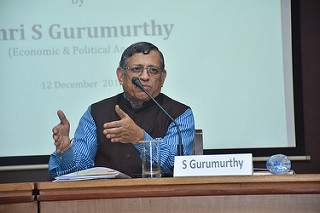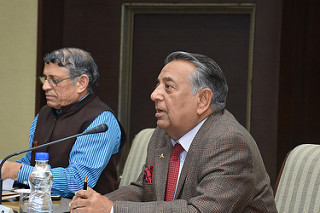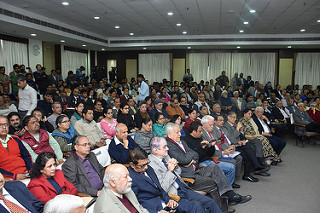The Vivekananda International Foundation held its monthly ‘Vimarsha’ on 12 December 2016 with eminent thinker and economist, Shri S Gurumurthy, widely acclaimed as a champion of ‘economic nationalism’ in India. As expected, the event attracted a large audience to listen to Shri Gurumurthy explaining the underpinnings of de-monetisation i.e. the sudden decision announced by the Hon’ble Prime Minister Mr. Narendra Modi last month to do away with Rs. 1000/- and 500/- currency notes. Shri Gurumurthy described the decision which has caught the imagination of most Indians as the biggest talking point today that is also destined to be the most dynamic and revolutionary economic initiative ever taken by the Government of India.
 The talk was preceded by the brief introductory remarks by General NC Vij, Director, VIF, wherein he explained the three-fold objectives of the de-monetisation initiative, namely, curbing the massive black money in the economy, rooting out corruption, and weeding out fake currency which lies at the core of terror financing in India. In this context, the Director found it strange that some of the political parties have chosen to aggressively and relentlessly oppose the path-breaking initiative, possibly due a sudden realization that the ground was slipping away under their feet with the de-monetisation denying them the political clout built around black money politics. Gen Vij did acknowledge that post–de-monetisation implementation exercise has caused some inconvenience to the public at large, but this he attributed to the critical requirement of maintaining utmost secrecy over such events. He complemented the vast majority of the common people who have been willingly braving the inconveniences as an inescapable fallout and a price that the nation has to pay to weed out black money and corruption from the system.
The talk was preceded by the brief introductory remarks by General NC Vij, Director, VIF, wherein he explained the three-fold objectives of the de-monetisation initiative, namely, curbing the massive black money in the economy, rooting out corruption, and weeding out fake currency which lies at the core of terror financing in India. In this context, the Director found it strange that some of the political parties have chosen to aggressively and relentlessly oppose the path-breaking initiative, possibly due a sudden realization that the ground was slipping away under their feet with the de-monetisation denying them the political clout built around black money politics. Gen Vij did acknowledge that post–de-monetisation implementation exercise has caused some inconvenience to the public at large, but this he attributed to the critical requirement of maintaining utmost secrecy over such events. He complemented the vast majority of the common people who have been willingly braving the inconveniences as an inescapable fallout and a price that the nation has to pay to weed out black money and corruption from the system.
 In a highly illuminating talk of nearly an hour, Shri Gurumurthy presented data on a large set of relevant economic indicators for two block periods of 1999-2004 under the NDA regime and 2004-2010 of the UPA rule to press home the point that the de-monetisation was not only necessary but timely and inescapable. In his characteristic style, he spiced his presentation with liberal doses of humour and sarcasm to explain the underlying dynamics of what he called a ‘Financial Pokharan’ that will bring about a paradigm shift in India’s economy. He stressed that while de-monetisation was essentially aimed at organising the unorganised sectors of the economy, it also has the potentials to tame down the high real estate prices and bring about much-needed transparency in the management of the economy. He further explained that de-monetisation had become inevitable due to ‘total mismanagement’ of the economy, especially with asset-inflation fuelling the GDP growth during the erstwhile UPA’s regime. While economy under Shri Manmohan Singh’s watch grew over 8 percent, there was no corresponding increase in job creations in the country, with only 2.7 million jobs created between 2004 and 2010.
In a highly illuminating talk of nearly an hour, Shri Gurumurthy presented data on a large set of relevant economic indicators for two block periods of 1999-2004 under the NDA regime and 2004-2010 of the UPA rule to press home the point that the de-monetisation was not only necessary but timely and inescapable. In his characteristic style, he spiced his presentation with liberal doses of humour and sarcasm to explain the underlying dynamics of what he called a ‘Financial Pokharan’ that will bring about a paradigm shift in India’s economy. He stressed that while de-monetisation was essentially aimed at organising the unorganised sectors of the economy, it also has the potentials to tame down the high real estate prices and bring about much-needed transparency in the management of the economy. He further explained that de-monetisation had become inevitable due to ‘total mismanagement’ of the economy, especially with asset-inflation fuelling the GDP growth during the erstwhile UPA’s regime. While economy under Shri Manmohan Singh’s watch grew over 8 percent, there was no corresponding increase in job creations in the country, with only 2.7 million jobs created between 2004 and 2010.  By contrasts, 60 million jobs were created and a record number of people were lifted out of poverty during the previous NDA’s regime which was led by Shri Atal Bihari Vajpayee even though the GDP growth hovered around a modest 4.5 %.
By contrasts, 60 million jobs were created and a record number of people were lifted out of poverty during the previous NDA’s regime which was led by Shri Atal Bihari Vajpayee even though the GDP growth hovered around a modest 4.5 %.
Shri Gurumurthy further underlined that black money generates black wealth. Since de-monetisation exercise got underway almost a month back, real estate prices have fallen sharply, leading to significant depletion in black wealth in the country. He also explained that there was surplus cash in the economy which required to be weeded out urgently. The Government was simply faced with a piquant ‘now or never’ situation. If the de-monetisation exercise was not undertaken now, it would have remained ‘undoable’ in the near future. Significantly, he stressed that even if all the de-monetised currency notes get ploughed back into the system, he would consider the present exercise a complete success since bulk of the ill-gotten or hidden wealth would now become part of the banking system for productive usage. In so far as the evasion of taxes is concerned, he said, this can be tackled later by the concerned agencies.
 Dealing with the impact on security related issues, he pointed out that by blocking black money coming in through banking and non-banking (Hawala) channels as well as through induction of counterfeit currency, de-monetisation will significantly squeeze the financial resources of the terrorists, as it is being seen in the country straight away. He explained with examples how de-monetisation was impacting the capacity of terror groups funded with a mix of black money and of counterfeit currency, forcing them to scale down their activities. It will, he argued, take the sponsors of these activities considerable time and effort to recover from the damage inflicted by de-monetisation.
Dealing with the impact on security related issues, he pointed out that by blocking black money coming in through banking and non-banking (Hawala) channels as well as through induction of counterfeit currency, de-monetisation will significantly squeeze the financial resources of the terrorists, as it is being seen in the country straight away. He explained with examples how de-monetisation was impacting the capacity of terror groups funded with a mix of black money and of counterfeit currency, forcing them to scale down their activities. It will, he argued, take the sponsors of these activities considerable time and effort to recover from the damage inflicted by de-monetisation.
Shri Gurumurthy’s expose was highly appreciated by the large audience which repeatedly applauded the presentation. A vigorous interactive session followed the talk, during which the well informed audience raised a range of issues and actions that must be taken by the Government to take the initiative to its natural conclusion.


